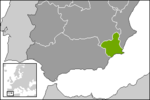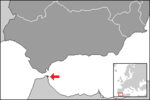List of provinces of Spain
Spain is divided into 17 autonomous communities and 2 autonomous cities (Ceuta and Melilla) with different degrees of autonomy. Below the autonomous communities, the state association is divided into 50 provinces . The current division is essentially based on the territorial reform carried out under Francisco Javier de Burgos in November 1833 - at that time there were 15 regions with a total of 49 provinces.
Many of the Spanish provinces are named after their respective capital. Only two cities, Mérida in Extremadura and Santiago de Compostela in Galicia , are capital of an autonomous region, but not capital of a province.
Seven autonomous regions are made up of a single province: Asturias , Balearic Islands , Cantabria , La Rioja , Madrid , Murcia and Navarra .
The provinces themselves are subdivided into municipalities (span. Municipios ). See the list of municipalities in the respective provinces.
Institutions and function
In those Autonomous Communities that consist of several provinces, the provinces each have a Diputación Provincial as a self-governing body between the region and municipalities ( municipios ). The Canary Islands are an exception. Here the Cabildos take the place of the Diputaciones.
In addition, the division into provinces is used by the Spanish central administration and for statistical purposes.
In the elections to the Spanish parliament, the provinces and the two autonomous cities of Ceuta and Melilla, which do not belong to any province, serve as constituencies. In each province, a number of representatives corresponding to the number of inhabitants is elected according to proportional representation.
In contrast to the German rural districts , the functions are not combined in one administration, but are organizationally separated from each other: on the one hand there is the Diputación Provincial with its administration, on the other hand the Subdelegación del Gobierno (or in the uniprovincial autonomous communities the Delegación del Gobierno ) as territorial unit of state administration. This is similar to the situation in Bavaria, where on the one hand, the districts with the district administration as a self-governing body, and secondly, the district government as State resources authority for the same area of the same comprehensive administrative region coexist.
Provinces by Autonomous Communities
The 50 provinces are divided into the autonomous communities as follows:
| region | Capital | Provinces | main place | location | |
|---|---|---|---|---|---|
|
Andalucía |
Andalucía (English: Andalusia) is the southernmost of the autonomous communities on the mainland. Of all the Spanish regions, Andalusia was the longest under Arab rule. The influences of the Muslims can still be seen today mainly in the architecture. | Seville |
|
Almeria |

|
|
|
Cadiz | ||||
|
|
Cordoba | ||||
|
|
Granada | ||||
|
|
Huelva | ||||
|
|
Jaén | ||||
|
|
Málaga | ||||
|
|
Seville | ||||
|
Aragon |
The territory of the Autonomous Community of Aragón (Aragon) corresponds to the former Kingdom of Aragon. The north of Aragon is characterized by the Pyrenees, the main ridge of which forms the northern border of the autonomous community along its entire length. | Zaragoza |
|
Huesca |

|
|
|
Teruel | ||||
|
|
Zaragoza | ||||
|
Asturies |
The territory of the Autonomous Community of Asturias (Asturias) is identical to that of the Province of Asturias (formerly Oviedo Province for a short time. Asturias is called Asturies in Asturian (called Asturiano or bable)). The vegetation is dominated by a lot of green (España Verde, the "green Spain"). | Oviedo |
|
Oviedo |

|
|
Illes Balears |
The autonomous community of Illes Balears (Balearic Islands) includes the main islands Mallorca and Menorca as well as the Pityuses with Ibiza and Formentera . In addition to these four and the fifth, by far the smallest inhabited island, Cabrera , the autonomous community of the Balearic Islands comprises 146 uninhabited islands. | Palma |
|
Palma |

|
|
Euskal Autonomia Erkidegoa |
For Euskal Autonomia Erkidegoa (Basque Country) is a part of the Spanish Basque country to which some have also parts of the Community of Navarra count. The Basque Country as a whole also includes the French Basque Country. | Gasteiz / Vitoria |
|
Gasteiz / Vitoria |

|
|
|
Donostia-San Sebastian | ||||
|
|
Bilbo / Bilbao | ||||
|
Canarias |
The Islas Canarias (Canary Islands) are an archipelago in the Atlantic that is geographically part of Africa, but politically part of Spain. All islands are of volcanic origin. |
Las Palmas de Gran Canaria + Santa Cruz de Tenerife |
|
Las Palmas de Gran Canaria |

|
|
|
Santa Cruz de Tenerife | ||||
|
Cantabria |
The Autonomous Community of Cantabria (Cantabria) consists only of the province of the same name (formerly Santander Province). Cantabria is hilly to mountainous. The highest peaks are in the Picos de Europa with peaks of over 2,000 m. | Santander |
|
Santander |

|
|
Castilla-La Mancha |
Castilla-La Mancha (Castile-La Mancha) belongs to the historical central Spanish landscape of Castile and is also known as New Castile. The province of Madrid also traditionally belonged to New Castile. The landscape of the Mancha became known through the figure of Don Quixote from the Mancha. | Toledo |
|
Albacete |

|
|
|
Ciudad Real | ||||
|
|
Cuenca | ||||
|
|
Guadalajara | ||||
|
|
Toledo | ||||
|
Castilla y León |
The eastern half of Castilla y León (Castile and León) belongs to the historical central Spanish landscape of Castile and is known as Old Castile, the western half forms the landscape of León. | Valladolid |
|
Ávila |

|
|
|
Burgos | ||||
|
|
Leon | ||||
|
|
Palencia | ||||
|
|
Salamanca | ||||
|
|
Segovia | ||||
|
|
Soria | ||||
|
|
Valladolid | ||||
|
|
Zamora | ||||
|
Catalunya |
Due to its historical and cultural characteristics, Catalunya (Catalonia) is one of the “historical autonomous communities” alongside the Basque Country and Galicia. Due to the historical, linguistic and cultural differences to the rest of Spain, many residents of the region believe that Catalonia is a nation in its own right. | Barcelona |
|
Barcelona |

|
|
|
Girona | ||||
|
|
Lleida | ||||
|
|
Tarragona | ||||
|
Extremadura |
Extremadura is one of the poorest regions in Spain. With a population density of 26.1 inhabitants per km², Extremadura covers 8.3% of the Spanish land mass, but only makes up 2.6% of the population of Spain. | Merida |
|
Badajoz |

|
|
|
Cáceres | ||||
|
Galicia |
The name Galicia (Galicia) goes back to the Celtic Galläker (also Callaik, Latin: Callaici ), a Celto-Iberian people who settled in this region in ancient times. The region is characterized by high mountain ranges that separate Galicia from the rest of Spain. | Santiago de Compostela |
|
A Coruña |

|
|
|
Lugo | ||||
|
|
Ourense | ||||
|
|
Pontevedra | ||||
|
Comunidad de Madrid |
The Comunidad de Madrid (Autonomous Community of Madrid) consists only of the province of the same name and the metropolitan area around the capital Madrid. | Madrid |
|
Madrid |

|
|
Murcia |
The Murcia region is identical to the province of the same name. The region is one of the driest areas in Europe (approx. 300 days of sunshine a year) and therefore suffers from water scarcity. | Murcia |
|
Murcia |

|
|
Navarre |
Navarre comprises the part of the historical Kingdom of Navarre located south of the Pyrenees . The Autonomous Community collects the taxes on its own territory and only pays a sum to the central state, which is determined by an agreement. | Pamplona |
|
Pamplona |

|
|
La Rioja |
The name La Rioja is a combination of “Río-Oja”, which means “Oja River”, which flows through the region into the Ebro. The climate is dry with a continental influence. | Logroño |
|
Logroño |

|
|
Comunidad Valenciana |
The Comunidad Valenciana (Land Valencia) is located on the Mediterranean coast. The territory is largely identical to that of the former Kingdom of Valencia, which belonged to the Crown of Aragon. | Valencia |
|
Alicante |

|
|
|
Castellón de la Plana | ||||
|
|
Valencia | ||||
|
Ceuta |
Ceuta is an autonomous Spanish exclave on the Mediterranean coast of Africa, near the Strait of Gibraltar, which belongs politically to Spain, but geographically to Africa. The 18.5 km² peninsula is known as a port of call for illegal immigration of Africans into the European Union. | Ceuta |

|
||
|
Melilla |
Melilla belongs politically to Spain, but geographically to Africa. Until 1995, Melilla was considered part of the province of Malaga. The city is located on a peninsula on the African continent and is secured with two fences, motion detectors, night vision devices and cameras to protect against illegal immigration. | Melilla |

|
Alphabetical overview table
history
The present Spanish provinces were created in 1833 by the administrative reform of Javier de Burgos . The larger historical territorial units were dissolved and the Spanish territory was divided into provinces of roughly equal size based on the model of the French departments , each named after their capital. Only the Basque provinces of Vizcaya , Guipúzcoa and Álava as well as Navarra retained their traditional tax autonomy and their old names.
The division into provinces remained the basis of the territorial division of Spain until the adoption of the new Spanish constitution of 1978 . Only during the second Spanish republic did Catalonia (from 1931) and the Basque Country (from 1936) have autonomous regional governments.
The 1978 constitution made it possible to form autonomous regions ( Comunidades Autónomas ) from one or more provinces. In the seven autonomous regions, which consist of only one province ( Asturias , Balearic Islands , Cantabria , La Rioja , Madrid , Murcia and Navarra ), the self-government functions of the provinces were transferred to the newly created regions. The provinces of Oviedo (Asturias), Palma de Mallorca ( Balearic Islands ), Santander (Cantabria) and Logroño ( La Rioja ) also adopted the name of the respective region instead of the name of the capital. In the other regions, the provinces continue to exist as a separate level of self-government. Especially in Catalonia, however, the provincial division is seen as artificial. Since 2010, a regional law has provided for the previous four provinces to be replaced by seven vegueríes .
